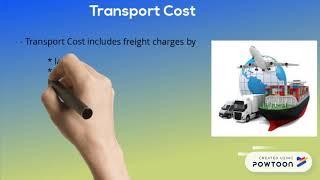In the intricate dance of global trade, the concept of laid-down cost logistics is like a hidden puppeteer pulling the strings behind the scenes. From the moment a shipment leaves its origin to the time it reaches its final destination, a complex web of transportation, shipping, and logistics decisions determine the ultimate cost incurred. And at the heart of it all lies the concept of laid-down cost – a term that encapsulates the total cost of a product, including all expenses from production to delivery. Join us as we unravel the intricacies of laid-down cost logistics and explore how this critical factor shapes the world of transport and shipping.
– Understanding the Concept of Laid-Down Cost in Shipping
When it comes to the shipping industry, understanding the concept of laid-down cost is crucial for effective logistics management. Laid-down cost refers to the total cost incurred to deliver a product to a specified location, including transportation, duties, taxes, and any other expenses associated with the shipment. This cost is often broken down into different categories to provide a clear picture of the expenses involved in shipping a product.
One of the key factors that affects laid-down cost is the mode of transportation used. Whether goods are shipped by air, sea, rail, or road can have a significant impact on the overall cost. Additionally, factors such as distance, weight, and size of the shipment can also influence the total cost. By understanding and effectively managing laid-down costs, companies can optimize their shipping processes, improve efficiency, and ultimately enhance their bottom line.

– Optimizing Logistics Strategies to Minimize Laid-Down Costs
When it comes to optimizing logistics strategies to minimize laid-down costs, it’s essential to consider various factors such as efficient transport routes, strategic shipping methods, and streamlined warehousing processes. By carefully analyzing each step of the supply chain, businesses can identify areas for improvement and implement cost-effective solutions that ultimately lead to savings.
One effective way to minimize laid-down costs is by integrating technology into logistics operations. Utilizing advanced software for route planning, inventory management, and real-time tracking can help companies optimize their resources, reduce waste, and improve overall efficiency. Additionally, fostering strong partnerships with reliable suppliers and carriers can ensure timely deliveries and minimize the risk of costly delays or disruptions. By continuously evaluating and fine-tuning logistics strategies, businesses can stay ahead of the competition and achieve long-term cost savings.

– Leveraging Technology for Efficient Transport Management
When it comes to efficient transport management, leveraging technology can significantly streamline operations and reduce costs. By implementing tracking systems and route optimization software, companies can ensure that their vehicles are always on the most efficient routes, saving both time and fuel. Additionally, the use of electronic logging devices can help with compliance and reporting, making it easier to stay on top of regulations and avoid fines.
Another way technology can improve transport management is through warehouse management systems that integrate with transportation systems. This seamless communication allows for better coordination between the warehouse and transport teams, leading to quicker loading times and fewer delays. In addition, real-time data analytics can provide valuable insights into performance metrics and help identify areas for improvement, ultimately leading to a more cost-effective and efficient operation.

– Best Practices for Reducing Laid-Down Costs in Shipping Operations
When it comes to reducing laid-down costs in shipping operations, there are several best practices that can help streamline processes and improve efficiency. One key strategy is to optimize route planning to minimize fuel consumption and transportation time. By utilizing advanced logistics software and real-time tracking systems, companies can identify the most cost-effective routes and make adjustments as needed.
Another effective way to reduce costs is to negotiate with suppliers for better pricing and terms. By establishing strong partnerships and leveraging economies of scale, companies can secure competitive rates and optimize their supply chain. Additionally, implementing cross-docking facilities and utilizing intermodal transportation can help cut down on handling and storage expenses. By adopting these best practices, companies can improve their bottom line and stay competitive in the ever-evolving shipping industry.
In Summary
In conclusion, the laid-down cost logistics approach offers a comprehensive solution for businesses looking to streamline their transportation and shipping processes. By considering all costs associated with getting goods from point A to point B, companies can make more informed decisions and improve their bottom line. Embracing this approach can lead to increased efficiency, reduced expenses, and ultimately, greater success in the competitive world of logistics. So, next time you’re evaluating your logistics strategy, remember to factor in the laid-down cost for a more sustainable and profitable outcome. Happy shipping!
